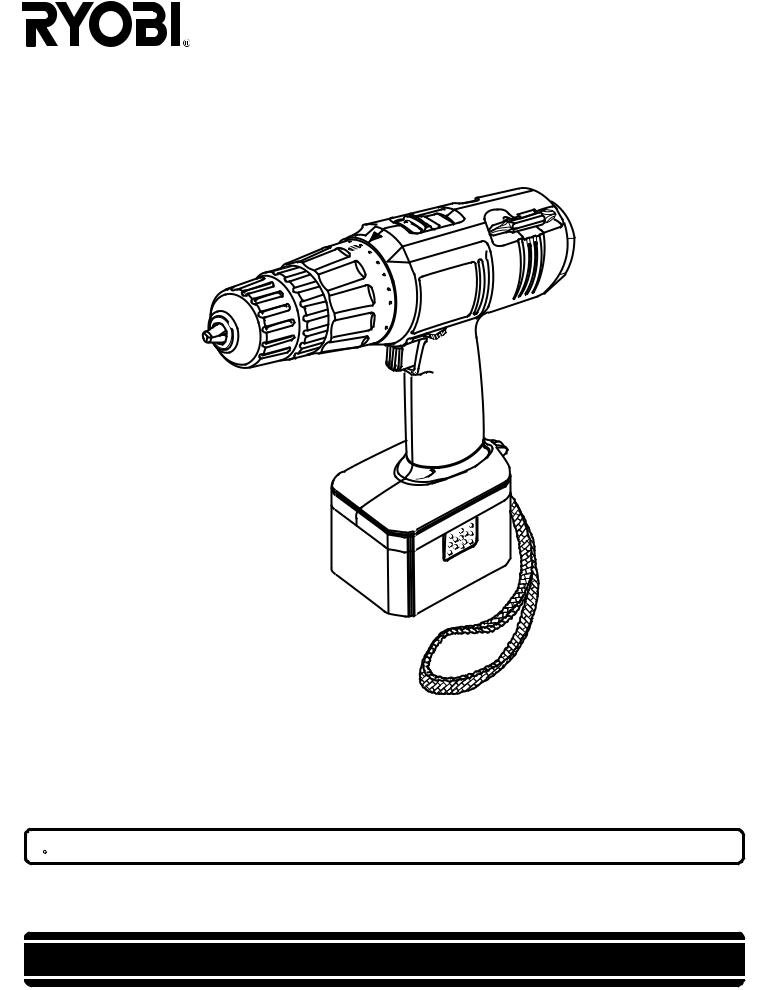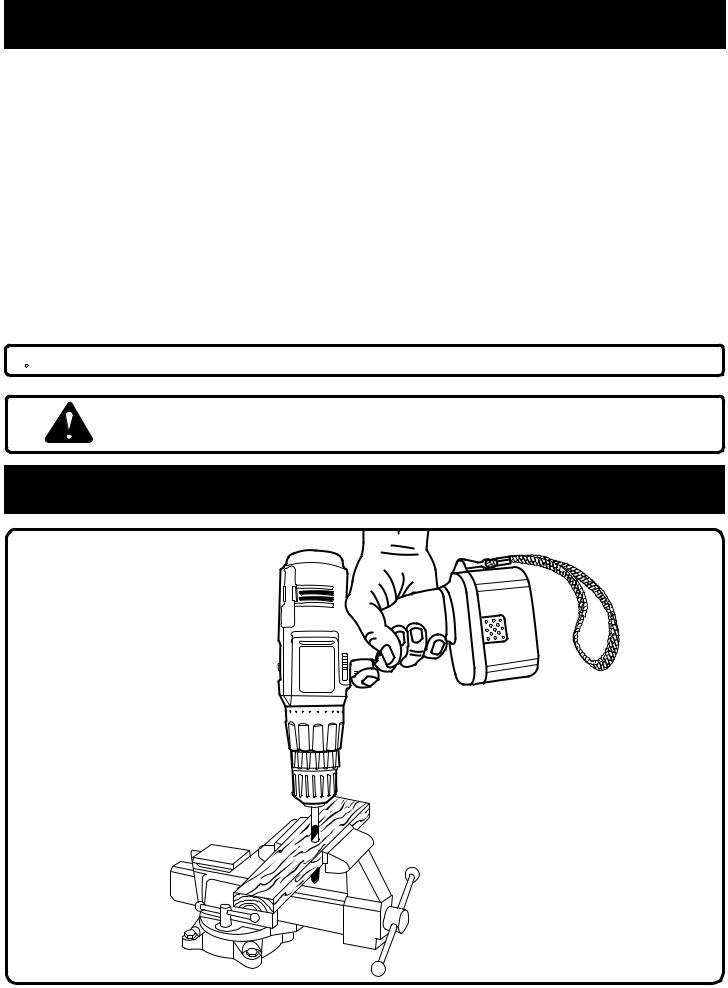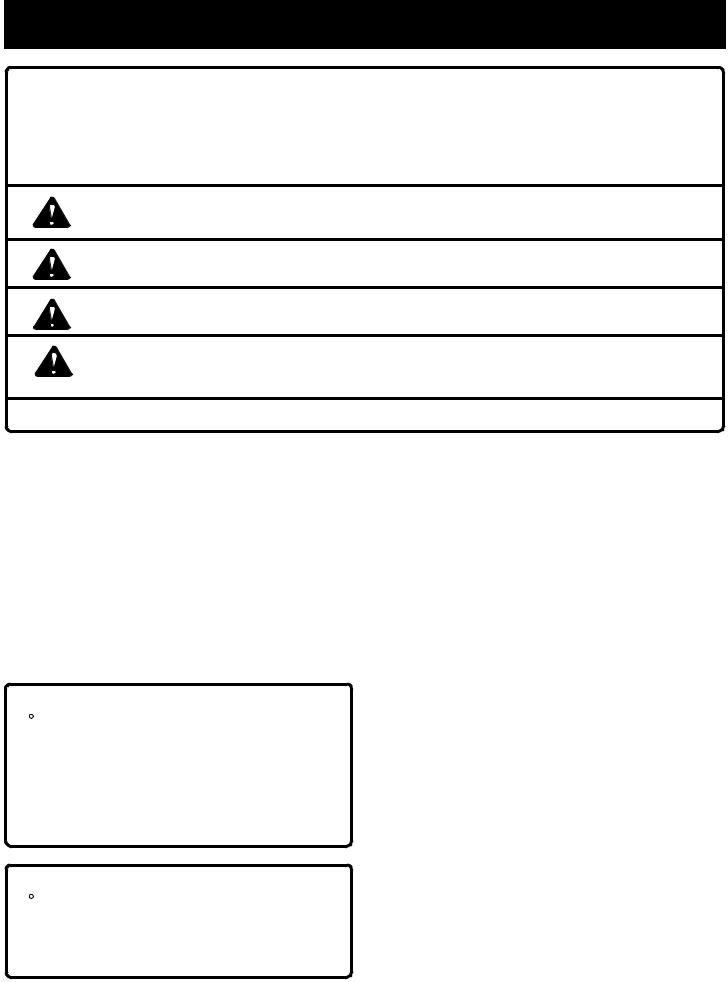Ryobi CTH1442K2, CTH1802, CTH1202K2 User Manual

OPERATOR'S MANUAL CORDLESS DRILL-DRIVER
MODEL NOS. CTH1202K2/CTH1442K2/CTH1802
2
22 20
18  16
16
THANK YOU FOR BUYING A RYOBI CORDLESS DRILL-DRIVER.
Your new cordless drill-driver has been engineered and manufactured to Ryobi’s high standard for dependability, ease of operation, and operator safety. Properly cared for, it will give you years of rugged, trouble-free performance.
 CAUTION: Carefully read through this entire operator's manual before using your new cordless drill-driver.
CAUTION: Carefully read through this entire operator's manual before using your new cordless drill-driver.
Pay close attention to the Rules for Safe Operation, Warnings, and Cautions. If you use your cordless drill-driver properly and only for what it is intended, you will enjoy years of safe, reliable service.
Thank you again for buying Ryobi tools.
SAVE THIS MANUAL FOR FUTURE REFERENCE

TABLE OF CONTENTS |
|
■ Table Of Contents/Typical Applications. ................................................................................ |
2 |
■ Rules For Safe Operation ................................................................................................... |
3-5 |
A. Precautions On Using Your Cordless Tool ....................................................................... |
4 |
B. Important Safety Instructions For Charger .................................................................... |
4-5 |
C. Precautions Regarding The Use Of Charger And Battery ............................................... |
5 |
■ Specifications ........................................................................................................................ |
6 |
■ Important Information For Recharging Hot Batteries............................................................. |
6 |
■ Disposal Of The Exhausted Battery ...................................................................................... |
6 |
A. Battery Pack Preparation For Recycling .......................................................................... |
6 |
■ Operation ........................................................................................................................ |
17-12 |
■ Maintenance ........................................................................................................................ |
13 |
■ Service Information ............................................................................................................. |
14 |
 CAUTION: Carefully read through this entire manual before using your new drill-driver.
CAUTION: Carefully read through this entire manual before using your new drill-driver.
Look for this symbol to point out important safety precautions. It means attention!!! Your safety is involved.
TYPICAL APPLICATIONS
22
20 |
18 |
16
DRILLING
Page 2

RULES FOR SAFE OPERATION
The purpose of safety symbols is to attract your attention to possible dangers. The safety symbols, and the explanations with them, deserve your careful attention and understanding. The safety warnings do not by themselves eliminate any danger. The instructions or warnings they give are not substitutes for proper accident prevention measures.
SYMBOL MEANING
SAFETY ALERT SYMBOL:
Indicates danger, warning or caution. May be used in conjunction with other symbols or pictographs.
DANGER: Failure to obey a safety warning will result in serious injury to yourself or to others. Always follow the safety precautions to reduce the risk of fire, electric shock, and personal injury.
WARNING: Failure to obey a safety warning can result in serious injury to yourself or to others. Always follow the safety precautions to reduce the risk of fire, electric shock and personal injury.
CAUTION: Failure to obey a safety warning may result in property damage or personal injury to yourself or to others. Always follow the safety precautions to reduce the risk of fire, electric shock and personal injury.
NOTE: Advises you of information or instructions vital to the operation or maintenance of the equipment.
KNOW YOUR CORDLESS TOOL
Safe operation of this cordless tool requires that you read and understand this Operator's Manual and all labels affixed to the tool. Learn its applications and limitations as well as the potential hazards related to a cordless tool. Keep this manual readily available for future reference.
IMPORTANT
Servicing of a tool requires extreme care and knowledge of the system and should be performed only by a qualified service technician. For service we suggest you return the tool to your nearest RYOBI AUTHORIZED SERVICE CENTER for repair. When servicing, use only identical Ryobi replacement parts.
 WARNING:
WARNING:
Do not attempt to operate this tool until you have read thoroughly and understand completely all instructions, safety rules, etc. contained in this manual. Failure to comply can result in accidents involving fire, electric shock, or serious personal injury. Save this operator's manual and review it frequently for continuing safe operation, and instructing others who may use this tool.
 WARNING:
WARNING:
When using power tools, basic safety precautions should always be followed to reduce the risk of fire, electric shock, and personal injury, including the following precautions.
READ ALL INSTRUCTIONS
1.KEEP THE WORK AREA CLEAN. Cluttered work areas and work benches invite injuries.
2.CONSIDER WORK AREA ENVIRONMENT. Keep work area well lit. Do not use tool in presence of flammable liquids or gases.
3.GUARD AGAINST ELECTRICAL SHOCK BY PEVENTING BODY CONTACT WITH GROUNDED SURFACES. For example: Pipes, radiators, ranges, refrigerator enclosures.
4.KEEP CHILDREN AND VISITORS AWAY. All visitors should wear safety glasses and be kept a safe distance from work area. Do not let visitors contact tool or extension cord.
5.STORE IDLE TOOLS. When not in use tools should be stored in a dry and high or locked-up place - out of the reach of children.
6.DON'T FORCE TOOL. It will do the job better and safer at the rate for which it was designed.
7.USE RIGHT TOOL. Don't force small tool or attachment to do the job of a heavy duty tool. Don't use tool for purpose not intended - for example - A circular saw should never be used for cutting tree limbs or logs.
8.WEAR PROPER APPAREL. Do not wear loose clothing or jewelry that can get caught in tool's moving parts and cause personal injury. Rubber gloves and nonskid footwear are recommended
Page 3

RULES FOR SAFE OPERATION (Continued)
when working outdoors. Wear protective hair covering to contain long hair and keep it from being drawn into nearby air vents.
9.ALWAYS WEAR SAFETY GLASSES. Everyday eyeglasses have only impact-resistant lenses; they are NOT safety glasses.
10.PROTECT YOUR LUNGS. Wear a face mask or dust mask if operation is dusty.
11.PROTECT YOUR HEARING. Wear hearing protection during extended periods of operation.
12.SECURE WORK. Use clamps or a vise to hold work. It's safer than using your hand and it frees both hands to operate tool.
13.DON'T OVERREACH. Keep proper footing and balance at all times. Do not use on a ladder or unstable support.
14.MAINTAIN TOOLS WITH CARE. Keep tools sharp at all times, and clean for best and safest performance. Follow instructions for lubricating and changing accessories.
15.REMOVE ADJUSTING KEYS AND WRENCHES.
Form habit of checking to see that keys and adjusting wrenches are removed from tool before turning it on.
16.AVOID UNINTENTIONAL STARTING. Do not carry the tool with your finger on the switch. Be sure switch is off when installing battery pack.
17.STAY ALERT. Watch what you are doing and use common sense. Do not operate tool when you are tired. Do not rush.
18.CHECK DAMAGED PARTS. Before further use of the tool, a guard or other part that is damaged should be carefully checked to determine that it will operate properly and perform its intended function. Check for alignment of moving parts, binding of moving parts, breakage of parts, mounting, and any other conditions that may affect its operation. A guard or other part that is damaged should be properly repaired or replaced by an authorized service center unless indicated elsewhere in this instruction manual.
19.DO NOT USE TOOL IF SWITCH DOES NOT TURN IT ON AND OFF. Have defective switches replaced by an authorized Ryobi Service Center.
20.DRUGS, ALCOHOL, MEDICATION. Do not operate tool while under the influence of drugs, alcohol, or any medication.
21.INSPECT FOR and remove all nails from lumber before drilling.
22.DO NOT CHARGE BATTERY TOOL IN A DAMP OR WET LOCATION.
PRECAUTIONS ON USING YOUR
CORDLESS TOOL
This product contains Nickel-Cadmium batteries which must be disposed of properly.
1.Be aware that this tool is always in an operating condition, because it does not have to be plugged into an electrical outlet.
2.First, charge the battery.
3.Be sure the battery is snapped in place.
4.When not in use, lock the switch.
5.When operating at a high place, be aware of things below you.
6.Before drilling into walls, ceilings, or floors, make sure that there are no concealed power cables inside.
 WARNING:
WARNING:
Drilling into electrical wiring in walls can cause drill bit and chuck to become electically live. Do not touch the chuck or metal housing when drilling into a wall; grasp only the insulated handle(s) provided on the tool.
IMPORTANT SAFETY INSTRUCTIONS FOR CHARGER
1.SAVE THESE INSTRUCTIONS. This manual contains important safety and operating instructions for charging the battery with the following components:
MODEL |
BATTERY |
CHARGER |
CTH1202K2 |
1400652 |
1400666 |
CTH1442K2 |
1400671 |
1400656 |
CTH1802 |
1400672 |
1400667 |
2.Before using battery charger, read all instructions and cautionary markings on (1) battery charger, (2) battery, and (3) products using battery.
 WARNING:
WARNING:
To reduce risk of injury, charge only nickelcadmium type rechargeable batteries. Other types of batteries may burst causing personal injury and damage.
3.Do not expose charger to rain or snow.
4.Use of an attachment not recommended or sold by the battery charger manufacturer may result in a risk of fire, electric shock, or injury to persons.
Page 4

RULES FOR SAFE OPERATION (Continued)
5.To reduce risk of damage to electric plug and cord, pull by the plug rather than the cord when disconnecting charger.
6.Make sure cord is located so that it will not be stepped on, tripped over, or otherwise subjected to damage or stress.
7.An extension cord should not be used unless absolutely necessary. Use of improper extension cord could result in a risk of fire and electric shock. If extension cord must be used, make sure:
a.That pins on plug of extension cord are the same number, size and shape as those of plug on charger.
b.That extension cord is properly wired and in good electrical condition; and
c.That wire size is large enough for AC ampere rating of charger as specified below:
Cord Length (Feet) |
25 ft. |
50 ft. |
100 ft. |
Cord Size (AWG) |
16 |
16 |
16 |
Note: AWG = American Wire Gage
8.Do not operate charger with damaged cord or plug. Replace immediately.
9.Do not operate charger if it has received a sharp blow, been dropped, or otherwise damaged in any way; take it to a RYOBI AUTHORIZED
SERVICE CENTER.
10.Do not disassemble charger; take it to a RYOBI AUTHORIZED SERVICE CENTER when service or repair is required. Incorrect reassembly may result in a risk of electric shock or fire.
11.To reduce risk of electric shock, unplug charger from outlet before attempting any maintenance or cleaning. Turning off controls will not reduce this risk.
PRECAUTIONS REGARDING THE USE OF CHARGER AND BATTERY
1.Do not charge battery when temperature is below 50° F (10° C) or above 95° F (35° C).
2.Never attempt to connect two chargers together.
3.The charger is designed to operate on standard household electrical power. Do not attempt to use it on any other voltage.
4.Consecutive charging may cause overheating. If you need to recharge batteries consecutively, wait for about 15 minutes to allow charger to cool.
5.Do not insert foreign matter into the hole for the battery in charger stand.
6.Do not charge by means of an engine generator or DC power source.
7.Do not disassemble the battery.
8.Do not store the tool and battery in locations
where the temperature may reach or exceed 104° F (40° C), such as outside sheds or metal buildings in summer.
9.Do not incinerate the battery, even if it is severely damaged or completely worn out. The battery may explode in fire.
10.Battery leakage may occur under conditions of extreme usage or temperature. If liquid comes in contact with skin, wash quickly with soap and water, then with lemon juice or vinegar. If liquid gets in your eyes, wash with water for at least 10 minutes and seek medical attention immediately.
11.Do not short-circuit the battery.
 WARNING:
WARNING:
Some dust created by power sanding, sawing, grinding, drilling, and other construction activities contains chemicals known to cause cancer, birth defects or other reproductive harm. Some examples of these chemicals are:
•lead from lead-based paints,
•crystalline silica from bricks and cement and other masonry products, and
•arsenic and chromium from chemically-treated lumber.
Your risk from these exposures varies, depending on how often you do this type of work. To reduce your exposure to these chemicals: work in a well ventilated area, and work with approved safety equipment, such as those dust masks that are specially designed to filter out microscopic particles.
SAVE THESE INSTRUCTIONS
Page 5
